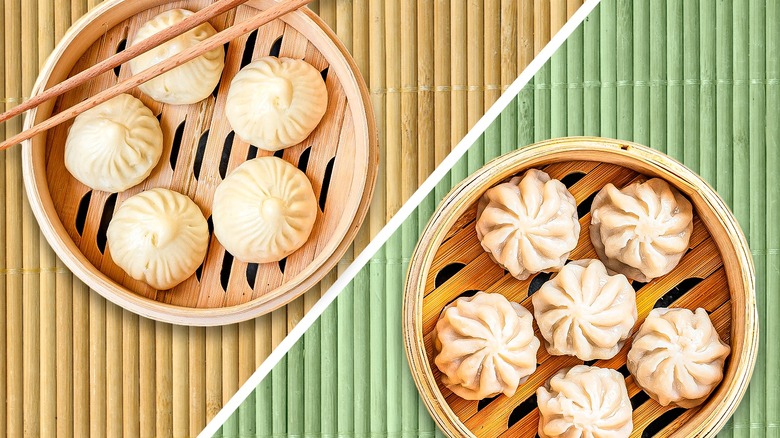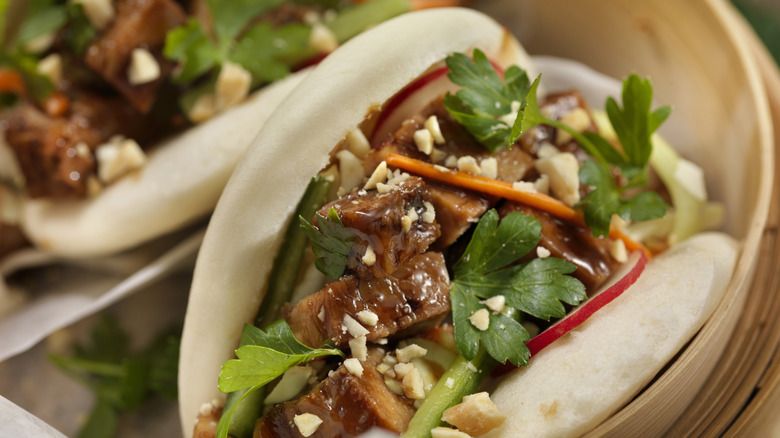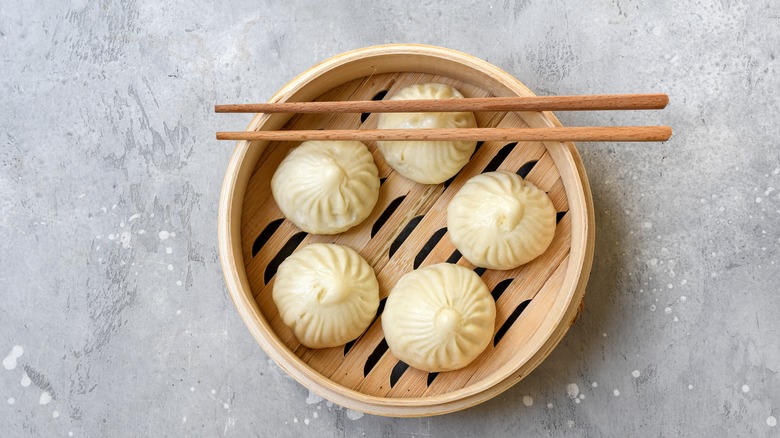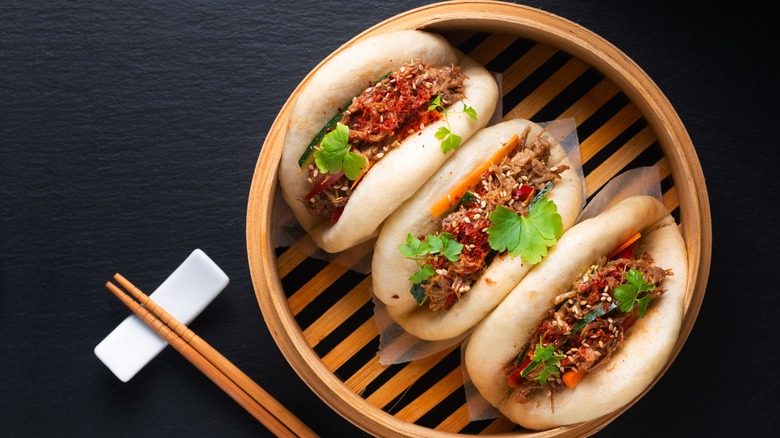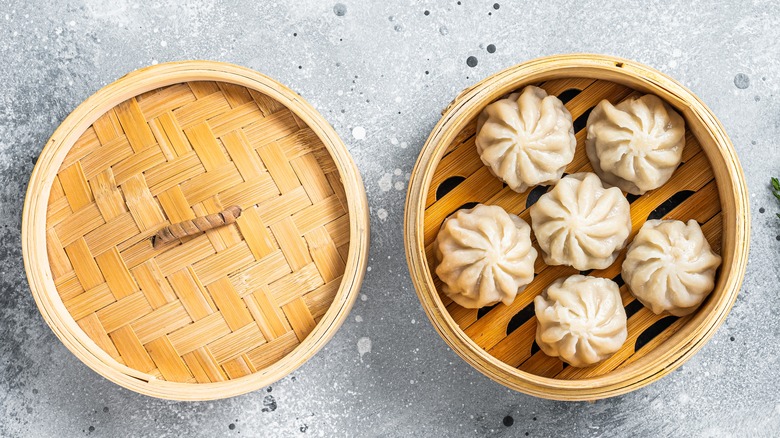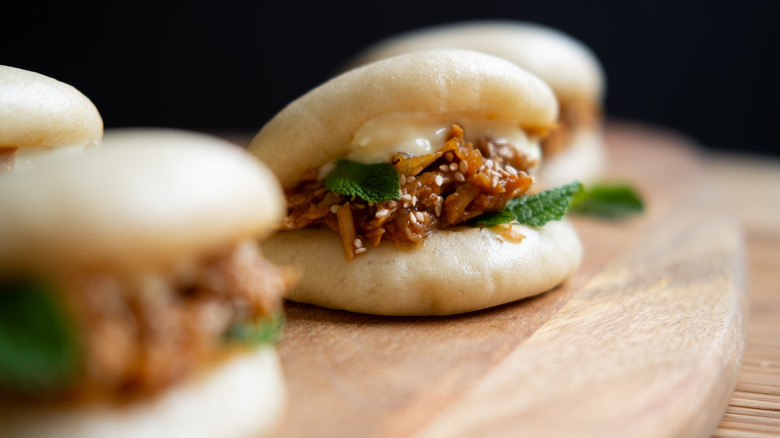The Difference Between Pork Buns And Bao
Step into the extensive world of Asian cuisine, and you'll discover two beloved treasures that have captured the hearts and palates of food enthusiasts around the globe: pork buns and bao. These delectable bites, with their origins deeply rooted in Chinese traditions, have transcended borders and become culinary symbols of comfort and satisfaction.
Pork buns, also known as char siu bao, feature soft, fluffy buns enveloping succulent, sweet-and-savory char siu pork fillings, creating a harmonious contrast of flavors and textures. Bao, on the other hand, are renowned for their tender, steamed exteriors and versatile fillings that range from char siu pork to an array of imaginative options, offering a symphony of flavors in every bite.
Whether you're a fan of the tender texture of bao or the savory allure of pork buns, sometimes people confuse these two dishes. But, with a little more information, you can grasp the key differences, such as the origins, fillings, doughs, and preparations, to better understand what sets pork buns and bao apart.
What are pork buns?
Pork buns, also known as char siu bao, trace their origins to Chinese cuisine. They have a rich history dating back to the ancient Silk Road, where merchants and travelers exchanged not only goods but culinary traditions. Over time, these savory buns evolved, adapting to regional tastes and preferences.
These soft, fluffy buns are filled with a succulent mixture of char siu, a sweet and savory barbecue pork. These buns are distinguished by their pale exteriors, which encase a flavorful, aromatic filling that's a balance of sweet and savory. The contrast of the tender, saucy pork with the pillowy, slightly sweet bun is what makes pork buns a beloved staple of Chinese cuisine. While the filling typically doesn't change within pork buns, they can feature additional garnishes, such as julienned vegetables and cilantro. However, the filling is not the only differentiating factor between pork buns and bao.
What are bao?
"Bao" is a broad term in Chinese cuisine and can refer to a variety of filled buns and dumplings. However, the bao we commonly encounter today — known for its fluffy, steamed exterior and sumptuous fillings — is believed to have originated in the northern regions of China. These delectable buns made their way southward and across borders, influencing the culinary landscapes of neighboring countries such as Japan, Korea, and Taiwan.
"Bao" is a catch-all term for various filled buns and dumplings in Chinese cuisine. However, when we refer to "bao" in the context of comparing it to pork buns, we are referring to the popular steamed bao. Unlike pork buns, steamed bao are pillowy, enclosed buns that can include far more than pork alone. However, you will not find similar garnishes inside or on top of bao. In addition to the filling, how bao is prepared and even the dough itself for the filled bun differs from pork buns.
Pork buns are only filled with pork
One of the biggest differences between pork buns and bao is the filling. When it comes to fluffy pork buns, they are synonymous with char siu, which is typically made from marinated, slow-roasted, or barbecued pork. The char siu filling is diced or shredded and imbued with a sweet and savory sauce that's rich and aromatic. It is, however, possible to see pork buns on a menu that are made with slices of pork that have not been shredded. While this is a less traditional option, it remains true to the dish's signature filling.
Bao, on the other hand, can feature a wide variety of fillings — including char siu pork. However, it is also easy to find varieties that are made with vegetables, seafood, or even sweet custard. Bao's versatility allows for an array of creative, delectable fillings and seemingly endless options. It isn't uncommon to see many different types of bao on a menu, so read the options closely.
Bao is made with a different type of dough
Another major difference that sets pork buns apart from the wider category of steamed bao is the dough that is used to make the buns or the dumpling itself. The distinction between pork bun dough and steamed bao dough lies in the composition and texture.
Often slightly sweet, pork bun dough is characterized by its soft and fluffy yet somewhat firmer texture. It typically includes common baking ingredients like all-purpose flour, sugar, water, and yeast, with the addition of milk or cream in some recipes. This dough serves as the perfect vessel to encase the flavorful char siu pork filling in pork buns, creating a delightful contrast of sweetness and tenderness.
Steamed bao dough is renowned for its delicate, pillowy softness. It achieves its ethereal texture through the use of yeast and steaming rather than baking. The dough typically includes all-purpose flour, sugar, water, yeast, and a small amount of fat, like vegetable oil or lard. The absence of milk and a slightly different proportion of ingredients give steamed bao its characteristic tender and airy quality, providing a harmonious balance to various fillings, whether savory or sweet. So, while both doughs share a foundation of basic ingredients, it's the ratios, the leavening method, and the steaming process that give each its unique texture and culinary charm.
Pork buns are not steamed
The final key distinction between pork buns and bao dumplings comes down to how they are cooked or prepared. Pork buns are traditionally baked or pan-fried, resulting in a slightly firmer outer layer. Because the buns are baked, they are drier and, therefore, are less sticky to pick up with your fingers.
Bao is unmistakably steamed, which imparts its characteristic soft and airy texture. The steaming process ensures a uniform, fluffy bun that practically melts in your mouth. It does, however, mean that the dumplings sometimes stick to the steamer basket when you try to pick them up with chopsticks. So, handle them gingerly to avoid tearing the bao dumpling open.
Ultimately, whether you find yourself craving the savory allure of pork buns or the tender embrace of bao, both of these Asian delights are a testament to the rich tapestry of culinary traditions that have transcended borders and delighted taste buds around the world. So, the next time you embark on a culinary adventure, consider indulging in the flavorful showdown between pork buns and bao and savor the distinctive pleasures each has to offer.
